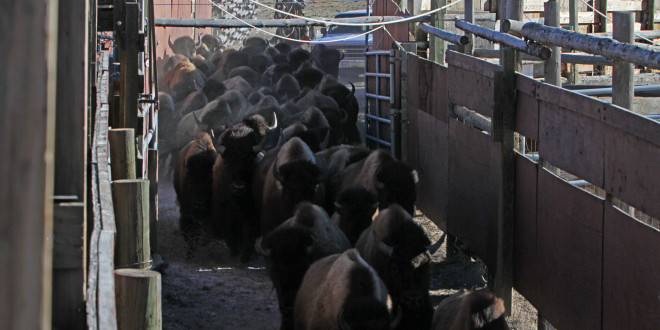Federal and state officials are hoping for a clear, quick resolution to Montana Governor Steve Bullock’s temporary halt on bison slaughter.
Earlier this week, we reported Governor Bullock had temporarily halted slaughter operations at Stephens Creek Bison Capture Facility in Yellowstone National Park over “disease concerns” and the fate of 40 bison promised to the Fort Peck tribe in northeastern Montana. The 40 bison have been held there since last year, when state veterinarian Marty Zaluski prohibited their transit out of the Park, citing concerns the animals were harboring brucellosis—in spite of testing negative for the disease multiple times.
Currently, there are 200 some bison at Stephens Creek. According to the Bozeman Daily Chronicle, Yellowstone Superintendent Dan Wenk has called for a quick resolution so the Park and other Interagency Bison Management Plan agencies can meet their quota of 900-1,300 bison. From the Chronicle:
“We have to be able to take advantage of winters like this in order to manage the population to the agreed upon size,” Wenk said.
On Thursday, Bullock spokeswoman Ronja Abel said they were “looking at early next week at the latest to get this resolved.”
[…]
Montana law requires that bison that are transported through the state to be released somewhere else be certified brucellosis free by the state veterinarian. Becoming brucellosis free requires a lengthy period of isolation in specifically designed corrals and repeated testing to ensure the disease doesn’t return.
Before the legal conflict bubbled over, Yellowstone set aside a group of bison it caught in 2016 to be transferred to Fort Peck once a final decision on the proposal was made. But the National Parks Service never issued a final decision on the Fort Peck proposal, so Yellowstone was planning to have the animals slaughtered.
On Jan. 19, Gov. Bullock sent the one-paragraph letter to Dan Wenk prohibiting the transport of bison. The letter referenced a 2011 executive order signed by then-Gov. Brian Schweitzer that prevented the slaughter of hundreds of bison that winter.
Mike Honeycutt, the executive officer of the Montana Department of Livestock, said they were involved in the decision to send the letter and fully supported it. He said the bison could either be sent to U.S. Department of Agriculture corrals a few miles down the road in Corwin Springs or be kept in the corrals at the park’s Stephens Creek Capture Facility for a while longer.
“It seems if there’s opportunities to find a solution, why give up at this point?” Honeycutt said.
Wenk has said Stephens Creek could hold the bison for another four weeks, but the facility is not built for long-term quarantine. Wenk also suggested the Corwin Springs corral as a possible holding pen for the 40 bison, but said this “simple, easy solution” might have more complications—especially if the USDA needs the Corwin Springs corral for research purposes. From the Chronicle:
The governor’s move has slowed the annual slaughter operations. Wenk said that before the park got the letter, it was going to begin shipping animals last week. They stop trapping bison before calving season, and Wenk worries if the prohibition lasts too long they won’t be able to meet the population reduction goals.
“We probably have six, maybe seven weeks left right now,” Wenk said. “If we don’t get started soon, we’re going to have a very, very difficult situation.”
Ensuring the prohibition is short is the main concern of the Montana Stockgrowers Association as well.
“As long as it’s short term and the culling operations continue, then yes, I think it is something we can work through,” said Errol Rice, the executive vice president of the Stockgrowers.
Bison advocates greeted Bullock’s move with a lukewarm reception. Dennis Jorgensen, of the World Wildlife Fund, has been working with the Fort Peck tribes to make quarantine happen there. The tribal government has built a quarantine facility that Jorgensen said is ready to help Yellowstone deal with bison population woes, and that Bullock’s move ignores that solution.
“He’s weighing in at the eleventh hour and saying, ‘oh, we can’t kill any bison,’” Jorgensen said. “But the solution is out there … Fort Peck has a quarantine facility.”
Jorgensen hopes that the Montana Legislature might change the state law that prevents bison from being transported there.
Stephany Seay, a member of the bison advocacy group Buffalo Field Campaign, praised the halt in slaughter but criticized the move to quarantine. The BFC, which is slated to meet the Montana Department of Transportation, advocates free-roaming bison and is “not in support of quarantine,” per Seay.
 Yellowstone Insider Your Complete Guide to America's First National Park
Yellowstone Insider Your Complete Guide to America's First National Park





